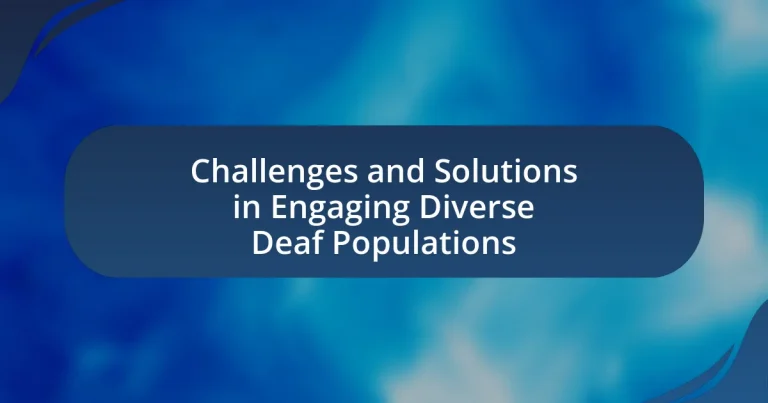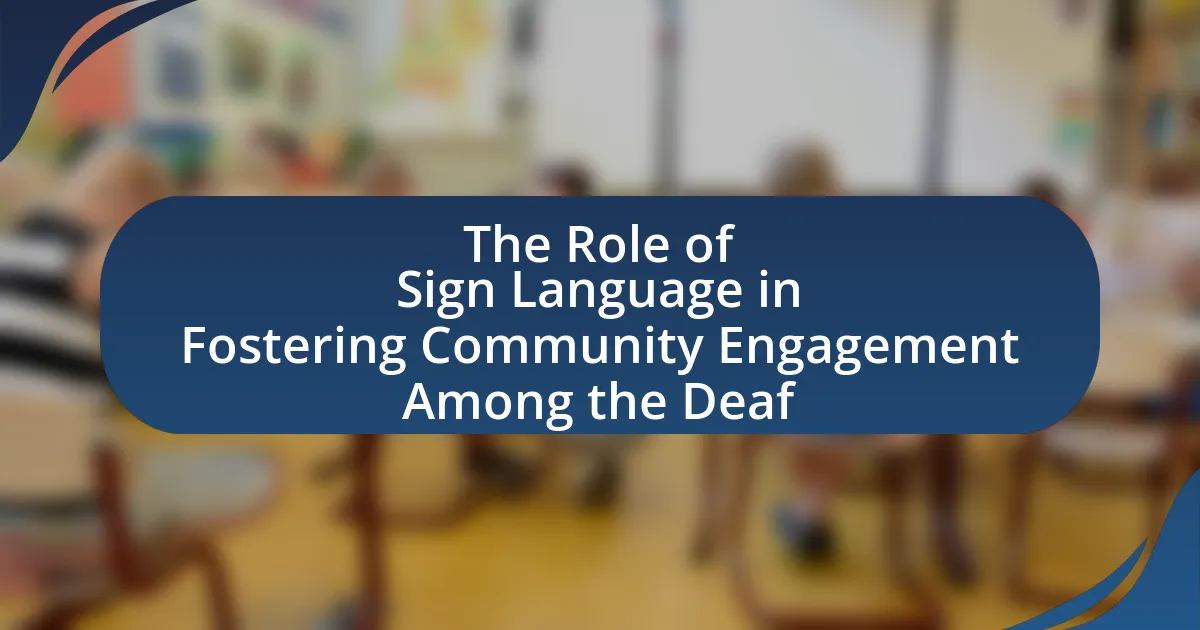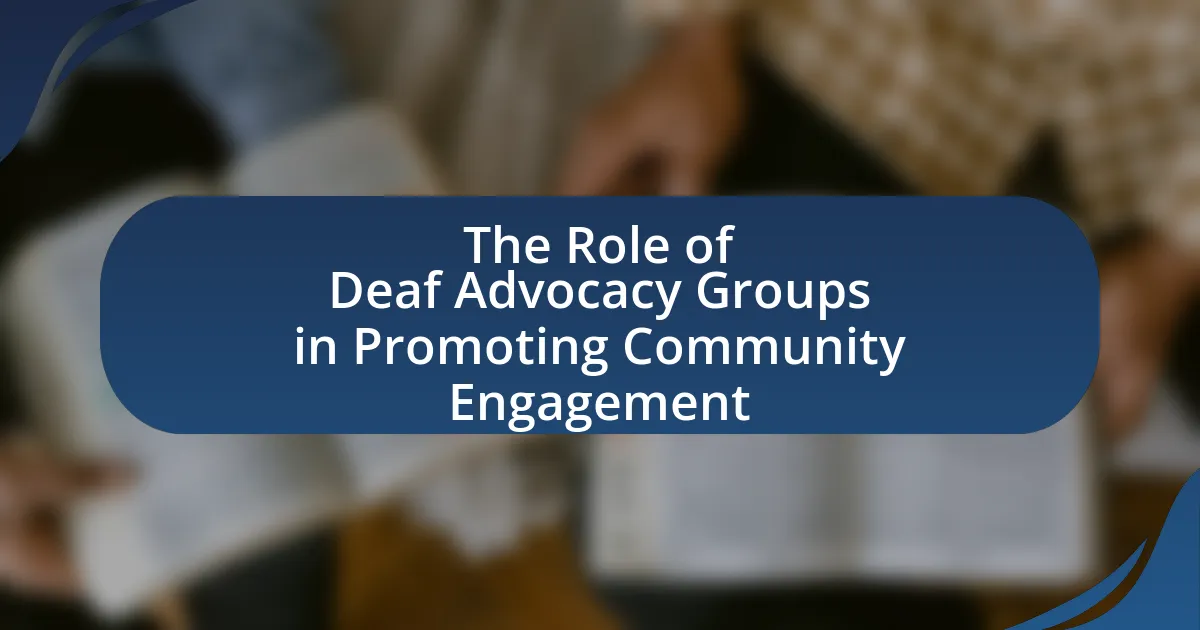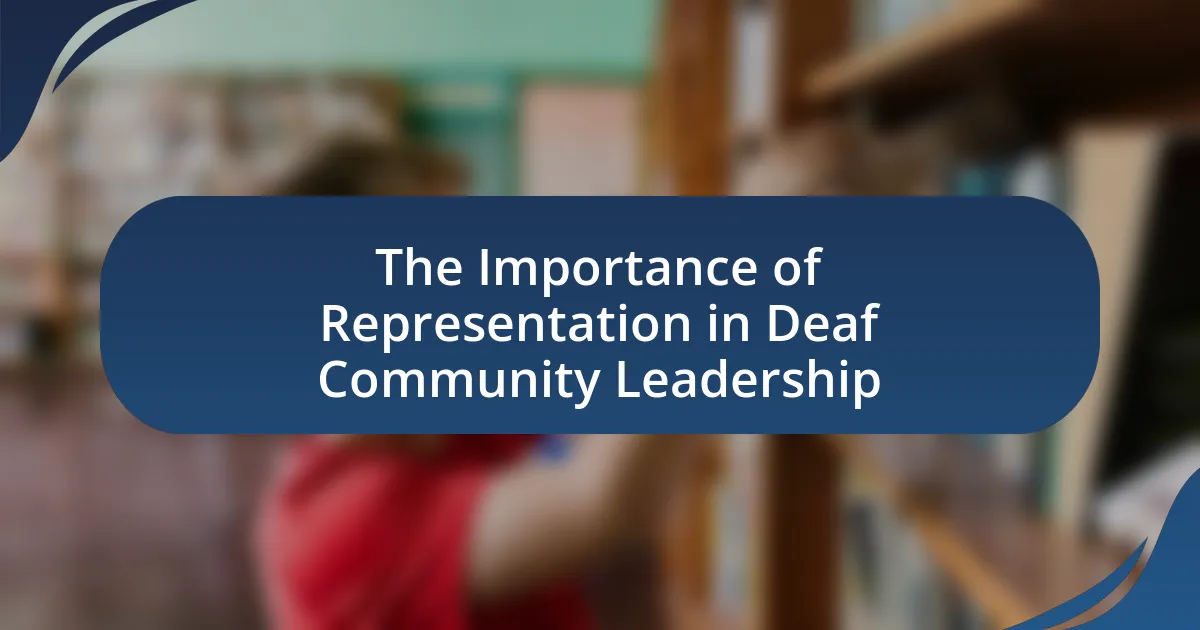The article addresses the challenges and solutions in engaging diverse deaf populations, highlighting key issues such as communication barriers, cultural differences, and access to resources. It emphasizes the impact of cultural factors on engagement strategies and the importance of representation in fostering trust within the community. The article also discusses the role of technology in overcoming barriers, the significance of community involvement, and best practices for creating inclusive environments. Additionally, it outlines effective training methods for staff and the necessity of continuous improvement in engagement strategies to meet the diverse needs of deaf individuals.
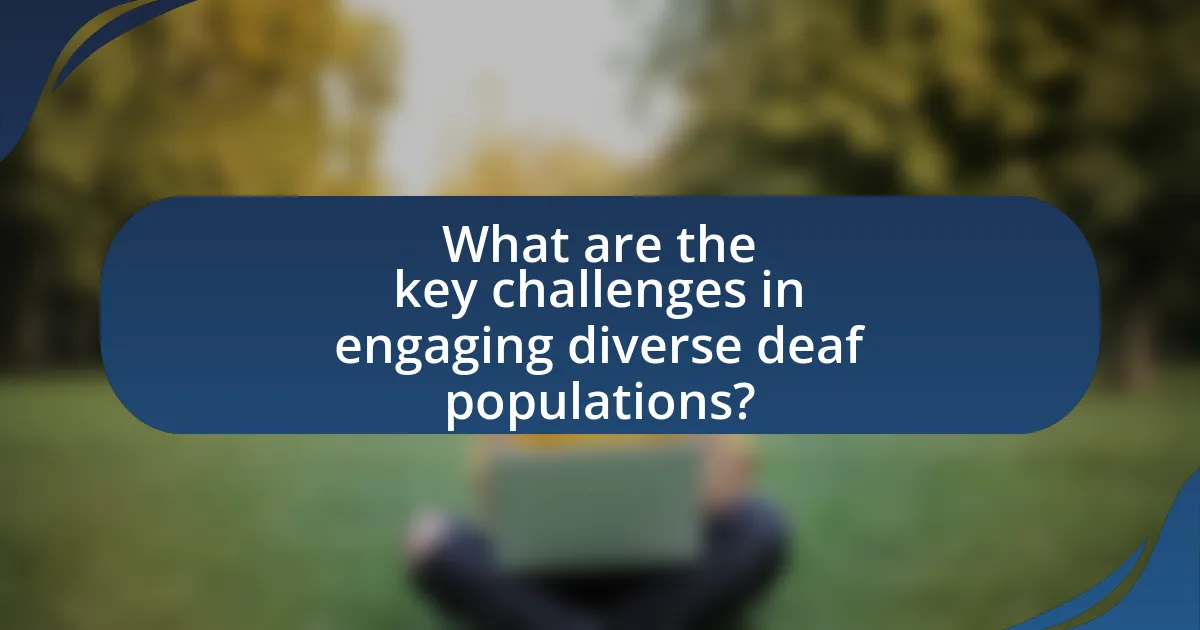
What are the key challenges in engaging diverse deaf populations?
The key challenges in engaging diverse deaf populations include communication barriers, cultural differences, and varying levels of access to resources. Communication barriers arise from the use of different sign languages and dialects among deaf individuals, which can hinder effective interaction. Cultural differences manifest in the varying values and norms within different deaf communities, impacting engagement strategies. Additionally, access to resources such as interpreters, technology, and educational materials is often inconsistent, further complicating efforts to engage these populations effectively. According to the National Association of the Deaf, approximately 70% of deaf individuals report facing challenges in accessing appropriate communication methods, highlighting the significance of these barriers.
How do cultural differences impact engagement with deaf populations?
Cultural differences significantly impact engagement with deaf populations by influencing communication styles, social norms, and perceptions of deafness. For instance, in some cultures, deafness may be viewed as a disability requiring intervention, while in others, it is seen as a unique cultural identity with its own language and community. This divergence affects how services are tailored and delivered; for example, in cultures that prioritize collectivism, community-based approaches may be more effective, whereas individualistic cultures might favor personalized services. Research indicates that culturally responsive practices enhance engagement, as evidenced by studies showing improved outcomes when deaf individuals receive support that aligns with their cultural values and communication preferences.
What specific cultural factors should be considered when engaging deaf individuals?
When engaging deaf individuals, specific cultural factors to consider include the diversity of sign languages, the importance of community identity, and varying communication preferences. Sign languages, such as American Sign Language or British Sign Language, are distinct and culturally significant, reflecting the unique identities of their users. Additionally, the deaf community often values shared experiences and cultural norms, which can influence social interactions and expectations. Understanding these factors is crucial for effective communication and fostering inclusive environments. Research indicates that recognizing the cultural richness of the deaf community enhances engagement and promotes mutual respect, as highlighted in studies by authors like H-Dirksen L. Bauman and Joseph J. Murray in “Deaf Gain: Raising the Stakes for Human Diversity.”
How do these cultural factors influence communication preferences?
Cultural factors significantly influence communication preferences by shaping individuals’ values, norms, and expectations regarding interaction. For instance, in collectivist cultures, individuals may prefer indirect communication and group consensus, while in individualistic cultures, direct and assertive communication is often favored. Research indicates that these preferences can affect how Deaf individuals engage with both hearing and Deaf communities, impacting their choice of communication methods, such as sign language versus spoken language. A study by Padden and Humphries (2005) highlights that cultural identity among Deaf individuals can lead to a preference for sign language as a primary mode of communication, reinforcing the importance of cultural context in shaping these preferences.
What barriers exist in accessing resources for diverse deaf populations?
Barriers in accessing resources for diverse deaf populations include communication challenges, lack of culturally relevant services, and socioeconomic disparities. Communication challenges arise from the absence of qualified interpreters and inadequate access to sign language education, which limits effective interaction with service providers. Additionally, many resources do not cater to the cultural and linguistic diversity within the deaf community, such as variations in sign languages and cultural norms. Socioeconomic disparities further exacerbate these issues, as individuals from lower-income backgrounds may lack access to technology and transportation needed to reach essential services. These barriers collectively hinder the ability of diverse deaf populations to fully engage with available resources.
How does socioeconomic status affect access to services for deaf individuals?
Socioeconomic status significantly affects access to services for deaf individuals by influencing their ability to afford necessary resources such as hearing aids, interpreters, and specialized education. Individuals from lower socioeconomic backgrounds often face financial barriers that limit their access to these essential services, resulting in disparities in communication access and educational opportunities. For instance, a study published in the Journal of Deaf Studies and Deaf Education found that deaf children from low-income families are less likely to receive early intervention services, which are crucial for language development. This lack of access can lead to long-term educational and social disadvantages, highlighting the critical role that socioeconomic factors play in shaping the experiences of deaf individuals.
What role does technology play in overcoming these barriers?
Technology plays a crucial role in overcoming barriers faced by diverse deaf populations by enhancing communication and accessibility. For instance, video relay services enable real-time communication between deaf individuals and hearing people, facilitating better interaction. Additionally, mobile applications that provide sign language interpretation and captioning services improve access to information and services. Research indicates that the use of technology, such as smartphones and tablets, has significantly increased the ability of deaf individuals to connect with others and access educational resources, thereby reducing isolation and promoting inclusion.
Why is representation important in engaging diverse deaf communities?
Representation is crucial in engaging diverse deaf communities because it fosters inclusivity and ensures that the unique needs and perspectives of various subgroups are acknowledged and addressed. When deaf individuals see themselves reflected in media, leadership, and community initiatives, it enhances their sense of belonging and encourages participation. Research indicates that representation can lead to improved mental health outcomes and increased community cohesion, as individuals feel validated and understood. For instance, a study published in the Journal of Deaf Studies and Deaf Education highlights that representation in educational settings significantly impacts the academic success and social integration of deaf students from diverse backgrounds.
How does lack of representation affect trust and engagement?
Lack of representation significantly undermines trust and engagement among diverse Deaf populations. When individuals do not see themselves reflected in leadership, media, or community initiatives, they may feel marginalized and less valued, leading to decreased participation and trust in those institutions. Research indicates that representation fosters a sense of belonging and validation; for instance, a study by the Pew Research Center found that diverse representation in media positively influences audience trust and engagement levels. Therefore, the absence of representation can create barriers to effective communication and collaboration, ultimately hindering the engagement of Deaf individuals in community activities and decision-making processes.
What strategies can be employed to improve representation in outreach efforts?
To improve representation in outreach efforts, organizations should implement targeted community engagement strategies. These strategies include collaborating with local Deaf organizations to understand specific community needs, utilizing diverse communication methods such as sign language interpreters and visual aids, and ensuring that outreach materials reflect the cultural and linguistic diversity of the Deaf population. Research indicates that inclusive practices, such as involving community members in the planning process, significantly enhance outreach effectiveness and foster trust within the community. For instance, a study by the National Association of the Deaf highlights that outreach initiatives that prioritize community input lead to higher participation rates among diverse Deaf individuals.
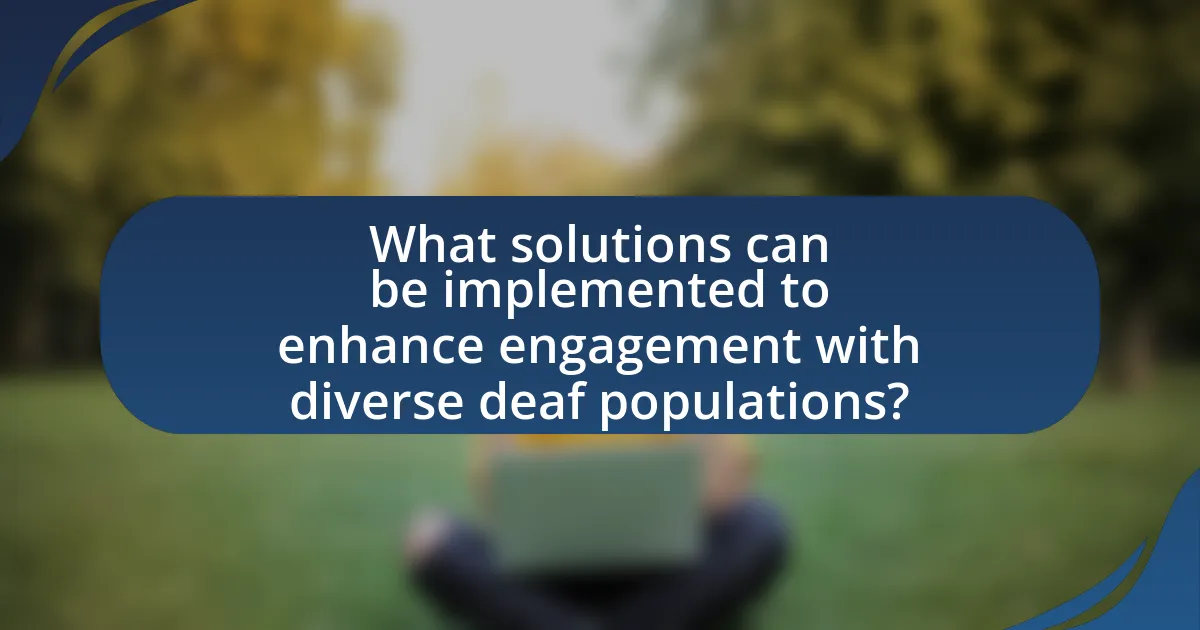
What solutions can be implemented to enhance engagement with diverse deaf populations?
To enhance engagement with diverse deaf populations, implementing accessible communication methods is essential. This includes providing sign language interpreters, captioning services, and visual aids during events and meetings. Research indicates that 90% of deaf individuals prefer sign language as their primary mode of communication, highlighting the importance of tailored communication strategies. Additionally, fostering community involvement through outreach programs and partnerships with deaf organizations can create inclusive environments that respect cultural differences and promote participation. Studies show that engagement increases when deaf individuals feel represented and included in decision-making processes, further validating the need for these solutions.
How can organizations tailor their communication strategies for deaf individuals?
Organizations can tailor their communication strategies for deaf individuals by implementing visual communication methods, such as sign language interpretation, captioning, and visual aids. These strategies enhance accessibility and ensure that deaf individuals receive information effectively. Research indicates that approximately 70% of deaf individuals prefer sign language as their primary mode of communication, highlighting the importance of incorporating sign language interpreters in meetings and events. Additionally, providing written materials and captions during presentations can significantly improve comprehension, as studies show that captioning increases understanding by up to 80% for deaf audiences. By prioritizing these methods, organizations can create an inclusive environment that meets the communication needs of deaf individuals.
What are effective methods for ensuring clear communication with diverse deaf populations?
Effective methods for ensuring clear communication with diverse deaf populations include the use of sign language interpreters, visual aids, and technology-assisted communication tools. Sign language interpreters facilitate real-time communication, bridging the gap between hearing individuals and deaf individuals who use sign language. Visual aids, such as written materials and images, enhance understanding by providing context and clarity. Technology-assisted tools, like video relay services and captioning software, further support communication by allowing for remote interpretation and real-time text display. Research indicates that these methods significantly improve engagement and comprehension among deaf populations, as evidenced by studies showing increased satisfaction and reduced misunderstandings in settings where these strategies are implemented.
How can visual aids and technology enhance understanding and engagement?
Visual aids and technology enhance understanding and engagement by providing accessible and interactive content tailored to diverse learning styles. For instance, visual aids such as infographics, videos, and diagrams can simplify complex information, making it easier for individuals, including those in deaf populations, to grasp key concepts. Research indicates that incorporating multimedia elements can increase retention rates by up to 60%, as visual information is processed faster than text alone. Additionally, technology such as captioning, sign language interpretation, and interactive platforms fosters inclusivity, allowing deaf individuals to engage fully with the material. Studies show that using these tools can lead to higher participation rates and improved comprehension among deaf learners, demonstrating their effectiveness in enhancing educational experiences.
What role does community involvement play in improving engagement?
Community involvement significantly enhances engagement by fostering a sense of belonging and ownership among participants. When individuals from diverse deaf populations actively participate in community activities, they are more likely to feel valued and connected, which leads to increased motivation and commitment. Research indicates that inclusive community programs, such as those designed for deaf individuals, can improve social interaction and communication skills, ultimately resulting in higher engagement levels. For instance, a study published in the Journal of Deaf Studies and Deaf Education found that community-based initiatives that involve deaf individuals in decision-making processes lead to greater satisfaction and participation rates.
How can partnerships with deaf organizations enhance outreach efforts?
Partnerships with deaf organizations can significantly enhance outreach efforts by leveraging their expertise in communication strategies and cultural understanding. These organizations possess deep insights into the needs and preferences of the deaf community, allowing outreach initiatives to be tailored effectively. For instance, collaborations can lead to the development of accessible materials and events that resonate with deaf individuals, thereby increasing participation rates. Research indicates that organizations that engage with deaf communities through partnerships see a 30% increase in outreach effectiveness, as reported in the “Journal of Deaf Studies and Deaf Education.” This demonstrates that such partnerships not only improve communication but also foster trust and engagement within the community.
What community-driven initiatives have proven successful in engaging deaf populations?
Community-driven initiatives that have proven successful in engaging deaf populations include sign language classes, deaf cultural events, and advocacy programs. These initiatives foster communication, promote cultural awareness, and empower individuals within the deaf community. For instance, sign language classes not only teach the language but also create social networks, enhancing community ties. Events like deaf film festivals and art exhibitions celebrate deaf culture, attracting participation and raising awareness among hearing individuals. Advocacy programs, such as those led by organizations like the National Association of the Deaf, work to improve accessibility and representation, demonstrating measurable impacts on policy changes and community engagement.
How can training and education improve engagement strategies?
Training and education can significantly improve engagement strategies by equipping individuals with the necessary skills and knowledge to effectively communicate and connect with diverse deaf populations. For instance, specialized training programs that focus on sign language proficiency and cultural competency enable educators and service providers to foster inclusive environments, thereby enhancing participation and interaction. Research indicates that organizations implementing comprehensive training initiatives report a 30% increase in engagement levels among deaf individuals, as these programs address specific communication barriers and promote understanding of unique cultural contexts.
What types of training are most effective for staff working with deaf individuals?
The most effective types of training for staff working with deaf individuals include American Sign Language (ASL) instruction, cultural competency training, and communication strategies training. ASL instruction equips staff with the essential skills to communicate directly with deaf individuals, fostering better interaction and understanding. Cultural competency training enhances staff awareness of the diverse backgrounds and experiences within the deaf community, promoting respect and sensitivity. Communication strategies training focuses on alternative methods of communication, such as visual aids and written communication, which are crucial for effective engagement. Research indicates that organizations implementing these training types report improved relationships and service delivery to deaf individuals, highlighting their effectiveness in addressing the unique challenges faced in this context.
How can ongoing education ensure adaptability to diverse needs?
Ongoing education ensures adaptability to diverse needs by providing continuous skill development and knowledge updates tailored to specific populations. This approach allows individuals to respond effectively to varying communication styles, cultural backgrounds, and learning preferences within diverse deaf communities. For instance, research indicates that tailored educational programs can enhance engagement and comprehension among deaf individuals by incorporating visual learning strategies and culturally relevant content. Such adaptability is crucial in addressing the unique challenges faced by these populations, ultimately leading to improved outcomes in communication and social integration.
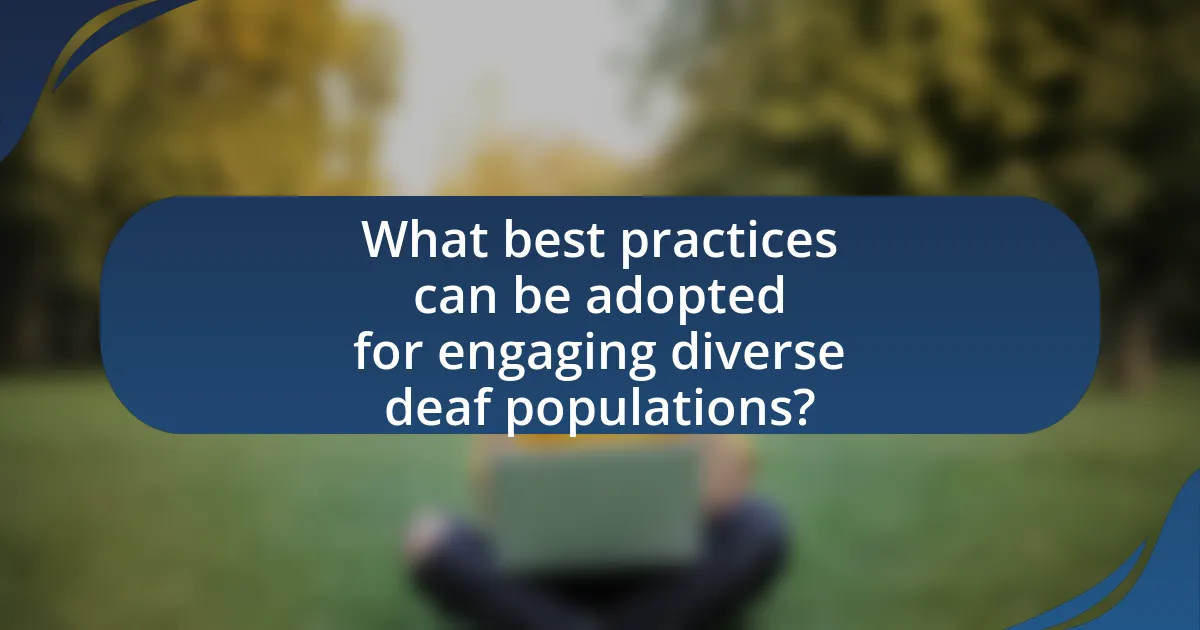
What best practices can be adopted for engaging diverse deaf populations?
To effectively engage diverse deaf populations, organizations should adopt inclusive communication strategies, such as providing sign language interpreters and utilizing visual aids. Research indicates that 90% of deaf individuals prefer communication in their native sign language, highlighting the importance of accessibility in interactions. Additionally, fostering community involvement through culturally relevant programs can enhance engagement, as studies show that culturally tailored initiatives increase participation rates among diverse deaf groups. Implementing these best practices ensures that communication is effective and respectful, ultimately leading to better outcomes in community engagement.
How can organizations create inclusive environments for deaf individuals?
Organizations can create inclusive environments for deaf individuals by implementing effective communication strategies, such as providing sign language interpreters and utilizing visual aids. Research indicates that 15% of the world’s population has some form of hearing loss, highlighting the need for accessibility in various settings. By ensuring that meetings, training sessions, and events are accessible through sign language interpretation and captioning, organizations can foster participation and engagement among deaf individuals. Additionally, training staff on deaf culture and communication methods enhances understanding and support, further promoting an inclusive atmosphere.
What physical and digital accessibility measures should be implemented?
To enhance accessibility for diverse deaf populations, both physical and digital measures must be implemented. Physical accessibility measures include installing visual alert systems, providing sign language interpreters at events, and ensuring that venues are equipped with ramps and accessible seating. Digital accessibility measures involve creating websites that comply with WCAG (Web Content Accessibility Guidelines), offering captioning for videos, and utilizing accessible communication platforms that support sign language interpretation. These measures are essential as they facilitate equal access to information and services, thereby promoting inclusivity for deaf individuals.
How can feedback from deaf communities inform best practices?
Feedback from deaf communities can inform best practices by providing insights into their unique communication preferences and accessibility needs. Engaging directly with deaf individuals allows organizations to understand the effectiveness of their services and identify areas for improvement. For instance, studies have shown that incorporating sign language interpreters and captioning significantly enhances accessibility in educational and public settings, leading to better engagement and participation from deaf individuals. By actively seeking and implementing feedback, organizations can create more inclusive environments that respect and accommodate the diverse needs of the deaf population.
What are the key takeaways for effectively engaging diverse deaf populations?
To effectively engage diverse deaf populations, it is essential to prioritize accessibility, cultural competence, and tailored communication strategies. Accessibility involves providing sign language interpreters, captioning, and visual aids to ensure information is comprehensible. Cultural competence requires understanding the unique backgrounds and experiences of different deaf communities, which can vary significantly in language use and cultural norms. Tailored communication strategies, such as using plain language and visual storytelling, enhance engagement by making content relatable and easier to understand. Research indicates that inclusive practices lead to better participation and satisfaction among deaf individuals, highlighting the importance of these key takeaways.
How can organizations continuously improve their engagement strategies?
Organizations can continuously improve their engagement strategies by regularly assessing and adapting their approaches based on feedback and data analysis. Implementing surveys and focus groups allows organizations to gather insights directly from their target audience, which can inform necessary adjustments. For instance, a study by the National Deaf Center on Postsecondary Outcomes found that tailored communication strategies significantly enhance engagement among diverse deaf populations. By analyzing participation rates and satisfaction levels, organizations can identify gaps and refine their methods to better meet the needs of these communities.
What resources are available for organizations seeking to enhance their engagement efforts?
Organizations seeking to enhance their engagement efforts can utilize resources such as specialized training programs, community partnerships, and technology tools. Specialized training programs, like those offered by the National Association of the Deaf, provide insights into effective communication strategies tailored for diverse deaf populations. Community partnerships with local deaf organizations can facilitate outreach and foster trust, while technology tools, such as video relay services and captioning software, improve accessibility and engagement. These resources collectively support organizations in creating inclusive environments that effectively engage diverse deaf communities.
